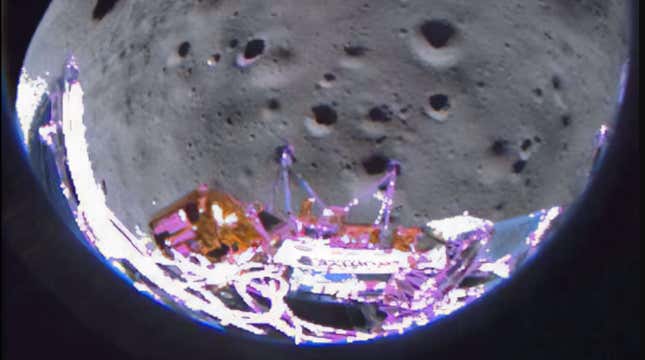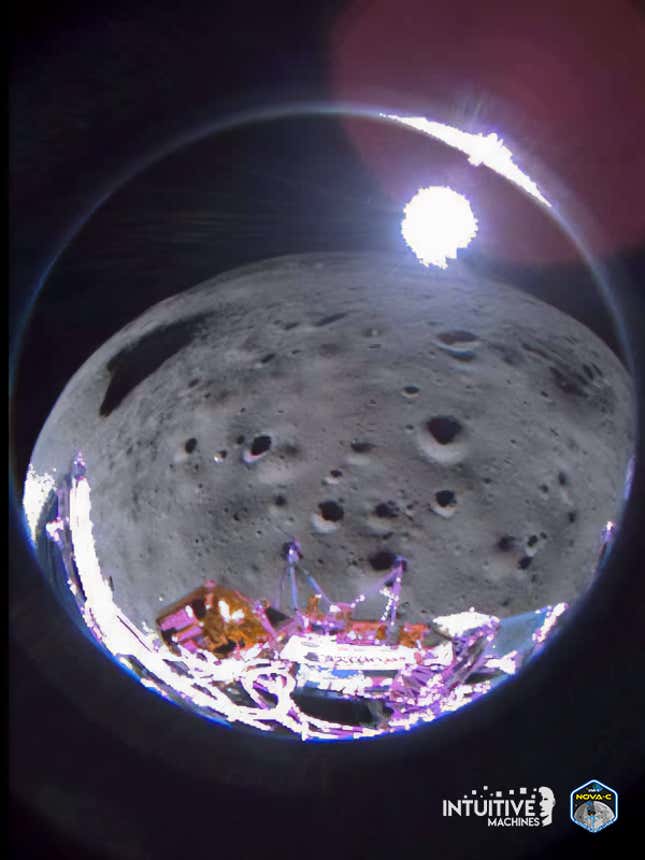Following a less-than-perfect touchdown, the Odysseus lander has been spotted from lunar orbit while lying on its side on the surface of the Moon. The lunar lander also beamed back its first images from the Moon as it fights to stay alive before it runs out of power.
NASA’s Lunar Reconnaissance Orbiter (LRO) captured images of the lander on Saturday at 1:57 p.m. ET. From the images, Intuitive Machines was able to determine that its IM-1 mission landed less than a mile away (1.5 kilometers) from its intended landing spot near the Malapert A crater in the Moon’s south pole region, the company wrote on X.

Intuitive Machines also shared the first images captured by Odysseus during its descent to the lunar surface. Odysseus touched down on the Moon on Thursday evening, becoming the first commercial vehicle to land on the Moon.
Prior to its descent, the lander’s laser rangefinders, which are designed to assess the Moon’s terrain to identify a safe landing spot, malfunctioned. In order to help Odysseus on its way down, flight engineers uploaded a software patch to repurpose a secondary laser on a NASA payload on board the lander.

The lander made it to the surface but ended up sideways, lying horizontally on what may be a lunar rock. Some of the antennas that the lander is designed to use to communicate with Earth are pointed downward, which made it hard for Odysseus to transmit data to ground control at first. The lander seems to have gotten the hang of it for now, beaming back those early images from the lunar surface.
With the lander on its side, it is still receiving sunlight to its horizontal solar panel. Intuitive Machines anticipates that Odysseus’ horizontal solar panel will only be exposed to light until Tuesday morning. After which, the company may no longer be able to communicate with its spacecraft.
The lander was originally designed to last for around a week on the Moon. Although its time on the lunar surface may be cut a little bit shorter than intended, flight controllers will continue collecting as much data as they can until the lander is in the dark.
For more spaceflight in your life, follow us on X (formerly Twitter) and bookmark Gizmodo’s dedicated Spaceflight page.
Trending Products

Cooler Master MasterBox Q300L Micro-ATX Tower with Magnetic Design Dust Filter, Transparent Acrylic Side Panel…

ASUS TUF Gaming GT301 ZAKU II Edition ATX mid-Tower Compact case with Tempered Glass Side Panel, Honeycomb Front Panel…

ASUS TUF Gaming GT501 Mid-Tower Computer Case for up to EATX Motherboards with USB 3.0 Front Panel Cases GT501/GRY/WITH…

be quiet! Pure Base 500DX Black, Mid Tower ATX case, ARGB, 3 pre-installed Pure Wings 2, BGW37, tempered glass window

ASUS ROG Strix Helios GX601 White Edition RGB Mid-Tower Computer Case for ATX/EATX Motherboards with tempered glass…










